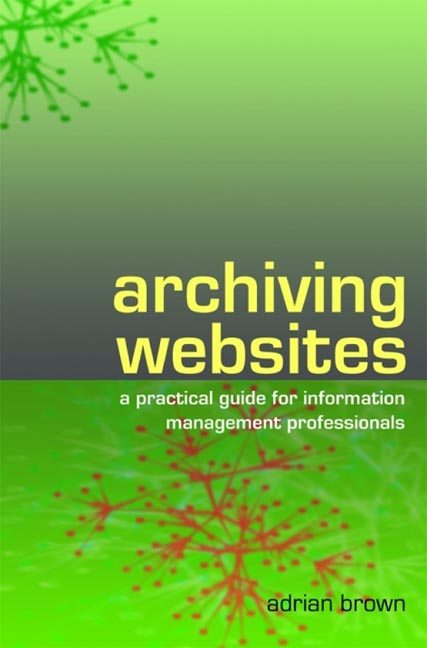Book contents
- Frontmatter
- Contents
- Acknowledgements
- Glossary
- 1 Introduction
- 2 The development of web archiving
- 3 Selection
- 4 Collection methods
- 5 Quality assurance and cataloguing
- 6 Preservation
- 7 Delivery to users
- 8 Legal issues
- 9 Managing a web archiving programme
- 10 Future trends
- Appendix 1 Web archiving and preservation tools
- Appendix 2 Model permissions form
- Appendix 3 Model test script
- Appendix 4 Model issues log
- Appendix 5 Model job description
- Bibliography
- Index
- Digital Preservation
- Frontmatter
- Contents
- Acknowledgements
- Glossary
- 1 Introduction
- 2 The development of web archiving
- 3 Selection
- 4 Collection methods
- 5 Quality assurance and cataloguing
- 6 Preservation
- 7 Delivery to users
- 8 Legal issues
- 9 Managing a web archiving programme
- 10 Future trends
- Appendix 1 Web archiving and preservation tools
- Appendix 2 Model permissions form
- Appendix 3 Model test script
- Appendix 4 Model issues log
- Appendix 5 Model job description
- Bibliography
- Index
- Digital Preservation
Summary
Introduction
It is unsurprising that a medium such as the web, which combines global impact and accessibility with the facility for very intimate and individual interaction, raises a plethora of complex legal issues. It is equally predictable that the archiving of web content would therefore be subject to similar legal complexities. Legislation may affect many aspects of web archiving, including the collection of content, its preservation, and the dissemination of that content to users.
First, the moral rights of individuals or organizations may be affected, most notably rights to privacy and rights over the protection of intellectual property. These rights may potentially be infringed by a number of web archiving activities, including collection, preservation and delivery. Human rights must also be considered, especially in the context of disseminating potentially distressing or offensive material.
Second, tensions may exist between the requirements of the selection policy and the governing legal framework. For example, it may be necessary to collect material that contravenes libel or obscenity laws. This may have a fundamental impact on the processes of collection, and especially on delivery.
Finally, a collecting organization may well be constrained or driven by its own legislative requirements, or those governing its potential content suppliers. This may include archival or legal deposit legislation, freedom of information legislation, or the demands of regulatory compliance or public accountability.
The legal situation is further complicated by the fact that the web is multijurisdictional: a web archiving programme may well be collecting content from sources, and very likely delivering that content to users, in many different countries governed by a wide variety of legislative frameworks.
Any organization planning to implement a web archiving programme must therefore be aware of all relevant legal requirements, and consider their potential impact on that programme. It is beyond the scope of this book to provide a detailed analysis of the specific national and international legislative requirements that may be relevant. Rather, this chapter provides a brief overview of the major issues to be considered, together with suggested sources of more detailed advice. It concentrates on examples from UK legislation, with reference to other regimes where appropriate.
- Type
- Chapter
- Information
- Archiving Websitesa practical guide for information management professionals, pp. 146 - 162Publisher: FacetPrint publication year: 2006
- 1
- Cited by

